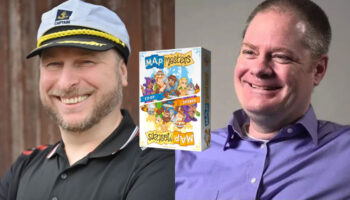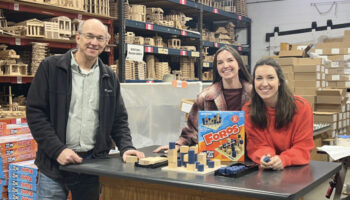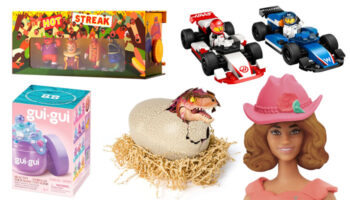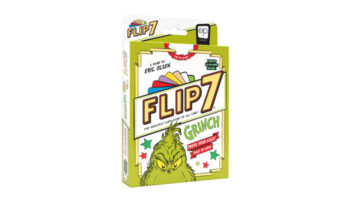Designer Robert Hovakimyan on the origins of his explosive take on tic-tac-toe, Bombastic

Robert, it’s great to connect. To kick us off, what set you on the path to game design?
Like most designers, it was a love of playing games at first. I got into the hobby around 2018 with titles like Rising Sun, Through The Ages, Gloomhaven and Twilight Imperium. In any art form that I enjoy, I tend to heavily subscribe to ‘auteur theory’ and categorise media by the creator’s name and often try my hand at being a creator as well. Games were no different.
Ah, so which game design auteurs were you inspired by?
The first big name on my radar was Eric Lang, but over the years I slowly shifted away from ‘American style’ games to more Euro style games, and specifically German games. Now, the three German Ks stand proudly at the top of my best designers list: Knizia, Kramer and Kiesling.
Or Reiner, Wolfgang and Michael to their friends! And what about their work resonates with you?
Well, Knizia specifically designs games that I just find absolutely marvelous. Listening to his interviews is what gave me the first inkling of trying my hand at it.
And when was this?
During the height of COVID lockdown. I became very active in the IV Games discord server, helping the team test their latest games and befriending many of the designers on the team – who remain great friends to this day. I also found my way into Vital Lacerda’s discord server and playtested some of his games there as well.
I saw that a lot of games start out totally dysfunctional – arguably boring – and seemingly hopeless. It wasn’t some magical talent that you needed to have to design games… It was a lot of hard work and perseverance, although talent and intuition certainly helps!). It was these behind the scenes insights that gave me the final push I needed to start designing myself.
I probably made 10 to 12 games that went through at least a few playtests, and two or three that had dozens of tests, before I finally designed a game that was any good. Then, in 2022, IV offered me a gig helping them work on Luminor and the rest is history!
The first game I signed with a publisher was Bitewing in 2023 and my first few designs came out from 2023 to now, with more on the way in 2026 and 2027.

Terrific. Bitewing is also the home of your latest launch, Bombastic – a fun new riff on tic-tac-toe. How did this idea come about?
Bombastic was kind of a magic trick, honestly. It is by far the game of mine that has come together the fastest.
My friend and fellow designer, Peter McPherson, mentioned that he had just ordered Sid Sackson’s A Gamut of Games. I decided that if Pete was reading it, I probably should be as well. So I picked up a copy and read through some games in the book. Initially, I was really digging through it for some inspiration, but it turns out when you’re trying too hard to look for inspiration, you often don’t find it.
I spent a few hours with the book one day, just playing some of the solitaire-compatible games and eventually got to the end. In the very back of the book, Sackson has a long compilation of games which didn’t make it into the book but he thinks are interesting. One of these games was titled ‘Blackout Tic Tac Toe’. Without reading another word, the entire game instantly came to mind.
Wow! Just from that name?
Just from the name. There would be a 3×3 grid of face-down tiles that had Xs and Os on them. 4 Xs and 4 Os… So what’s the ninth tile? Codenames snuck its little head in and said: “A bomb!”
So I was thinking of a super simple game where on your turn you either swapped two tiles, peeked at one tile, or went for it by flipping three in a row… You’d win if they are all yours, but lose if you flip the bomb.

And did Bitewing come to mind immediately for it?
Yes! I wrote those original rules out in the Bitewing group chat where I often share ideas with Nick, Kyle and our lovely editor Scott. But I was so excited I couldn’t wait for their response – I just had to test it. So I grabbed nine square tiles, drew Xs, Os, and a bomb on them and begged my wife to test this new idea at 8pm on a Saturday night. She obliged – gosh I love her!
Ha! And did it play as well as you’d hoped?
The game was fun, but it was missing something. My wife said she wanted it to be more chaotic… It felt a little too dry and one-note. The game wanted to be zanier and funnier than it currently was.
I guess I was in a really creative mood that day because as soon as she said that, I had the idea for the action cards. There would be two out at any given time and players would pick one to activate on their turn. This way, the actions players take would be much more varied, but still kept the number of options fairly small.
I went to my computer, opened a fresh Illustrator document, and created nine action cards. I messaged Nick that I had the game ready if he wanted to try it and he hopped onto Tabletop Simulator where we gave it a whirl. It was pretty dang fantastic and he wanted to sign it that same night.
Amazing! And you’ve also designed ‘heavier’ strategy titles. Does the experience of designing simpler games shape how you tackle heavier games, or vice versa?
Yes, it definitely does. While designing a heavier game is very different than designing a lighter one, I find the same thing holds true in both cases: The initial spark – or core concept – is always the best part of the game. And the initial spark accounts for a higher percentage of the total game the lighter the game is.
So lighter games really test whether or not your initial ideas are any good. With a heavier game, you can cover up the ‘not so good’ ideas with some other stuff and people won’t really notice the details. In a lighter game, your core idea stands naked in front of its audience with no fluff to hide its imperfections behind.
Getting good at designing light games means getting better at finding those initial sparks which serve as the core to your games. And no matter how heavy the game is, a better core leads to a better game.

Great answer! Looping back to Bombastic, what made Bitewing a good home for it?
Bitewing was a good fit for many reasons. Firstly, it would fit perfectly with their travel line and be, dare I say, the first game in the line that you can truly play anywhere. It fits on an airplane tray table! And the clamshell case felt like the perfect packaging for this one.
Additionally, I knew they were looking for a lighter game to publish because they had been pumping out a lot of medium weight games. Seeing Nick and Kyle’s initial enthusiasm for the game really helped, because I knew it would get care and attention with them since they believed in it. It wouldn’t just be a shot in the dark from some large publisher who puts out 10 small games a year hoping that one of them sticks. This would be Bitewing’s small game of the year, so they would have no choice but to push it at cons.
What’s the key to successful designer/publisher collaborations?
Respect, communication and faith. Pretty much all the stuff that’s the key to a good marriage is also the key to a successful designer/publisher collaboration.
Let’s dive into that a bit more. Respect in what sense?
Respecting that you are both in charge of different parts of the product. I am in charge of the mechanisms, they are in charge of everything else. They get final say when it comes to theme, art, name, marketing, and so on. Of course, I can chime in and offer my input, but I understand that they are the ones publishing the game. If I wanted to be in charge of all that stuff, I should have published it myself.
Got it! And communication?
If you aren’t happy with something, say it kindly and say it now. Don’t hold a grudge over each other. Confirm that you are both on the same page about what the game is, who it’s for or not for, and what it’s trying to do in the market.
Makes sense. And faith?
Have faith in each other. Even if you don’t quite understand why the publisher did something – and you would have done it a different way – have faith that they know what they are doing. You chose them because they have expertise you don’t, so believe in their ability to make your game the best product it can be.
Good answer! I have one last question! What fuels your creativity?
I get ideas at the most random times. Showers and right before going to sleep are the two big ones, but an idea can really hit any time anywhere. I guess the most concrete answer is that I am inspired by other games, so I try to play games as often as I can.
Robert, a huge thanks for making time – and congrats again on Bombastic.
–
To stay in the loop with the latest news, interviews and features from the world of toy and game design, sign up to our weekly newsletter here
























